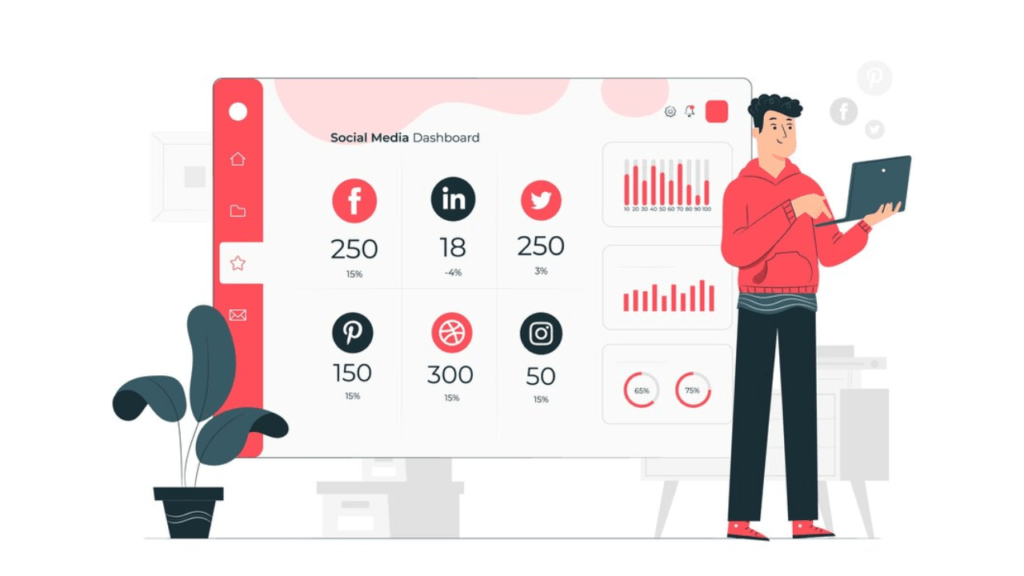
Introduction
A well-structured social media content strategy is the foundation of a strong digital presence. Whether you are an individual content creator, a small business, or a large enterprise, having a clear strategy ensures that your content reaches the right audience, drives engagement, and achieves measurable results.
With the rise of new platforms, algorithm changes, and increasing competition, a strategic approach to social media is more important than ever. A well-executed plan helps maintain consistency, build brand authority, and convert followers into loyal customers.
This guide will walk you through a step-by-step process to build an effective social media content strategy that boosts engagement, enhances brand awareness, and maximizes conversions.
What is a Social Media Content Strategy?
A social media content strategy is a detailed plan that outlines what, when, and how to post on different social media platforms. It ensures that content aligns with your brand’s goals, resonates with your audience, and contributes to overall business growth.
Why is a Social Media Content Strategy Important?
A well-thought-out strategy offers several benefits:
- Consistency – Posting regularly keeps your audience engaged and strengthens your brand identity.
- Efficiency – Planning content in advance saves time and streamlines your marketing efforts.
- Higher Engagement – Content tailored to your audience’s preferences leads to better interaction.
- Stronger Brand Positioning – A clear voice and message help establish credibility in your industry.
- Improved ROI – Strategic content creation leads to better conversions and sales.
- Better Performance Tracking – A structured plan allows for accurate measurement and data-driven decisions.
Without a solid social media content strategy, posting on social media can feel random and ineffective. The key is to develop a plan that keeps your audience engaged while supporting your business objectives.
Step-by-Step Guide to Creating a Successful Social Media Content Strategy

Step 1: Define Your Goals
Before posting content, it is essential to define what you want to achieve. Setting clear and measurable goals helps guide your strategy. Some common objectives include:
- Increasing brand awareness
- Driving website traffic
- Boosting engagement rates
- Generating leads and sales
- Building a community around your brand
Setting SMART goals—Specific, Measurable, Achievable, Relevant, and Time-bound—ensures that your strategy is focused and results-driven. For example:
- Increase engagement on Instagram by 30% within three months.
- Generate 500 new leads through LinkedIn by the end of the quarter.
Defining goals from the start will help in content planning, platform selection, and performance measurement.
Step 2: Understand Your Target Audience
A successful social media content strategy is built around your audience’s needs, preferences, and behaviors. Understanding your audience ensures that the content resonates and encourages engagement.
To identify your target audience, consider:
- Demographics: Age, gender, location, job title, and income level.
- Interests and Behaviors: What content do they consume? What are their pain points?
- Social Media Habits: Which platforms do they use the most? When are they most active?
Social media analytics tools, surveys, and customer feedback can provide valuable insights into your audience. The better you understand them, the more effective your content will be.
Step 3: Choose the Right Social Media Platforms

Not all social media platforms are suitable for every brand. Instead of being present everywhere, focus on the platforms where your target audience is most active.
Here is a breakdown of different platforms and their best use cases:
- Facebook: Best for community building, advertising, and long-form content.
- Instagram: Ideal for visual storytelling, product showcases, and influencer collaborations.
- LinkedIn: Most effective for B2B marketing, networking, and thought leadership.
- Twitter: Great for real-time updates, trending conversations, and customer service.
- Pinterest: Best for sharing visual content, DIY projects, and inspiration.
- TikTok: Excellent for short, engaging videos and viral marketing.
Choosing the right platforms ensures that your content reaches the right audience and generates the best possible engagement.
Step 4: Plan and Create High-Quality Content
A structured content plan ensures that your posts are consistent and aligned with your brand message. Content should be engaging, informative, and valuable to your audience.
Types of Engaging Social Media Content:
- Videos: Tutorials, behind-the-scenes content, product demos, and live sessions.
- Images: High-quality product shots, branded graphics, infographics, and memes.
- Text-Based Posts: Industry insights, tips, quotes, and updates.
- User-Generated Content (UGC): Sharing content created by your customers builds trust.
- Polls and Quizzes: Interactive content encourages audience participation.
- Stories and Reels: Short-form content boosts visibility and engagement.
A good mix of content types keeps your audience engaged and prevents your content from becoming repetitive.
Using the 80/20 rule—80% valuable, educational, and entertaining content, and 20% promotional content—ensures that your audience stays engaged without feeling overwhelmed by sales-driven posts.
Step 5: Develop a Content Calendar

A content calendar helps in organizing, scheduling, and maintaining a consistent posting routine.
Key elements of a content calendar include:
- Post topic or theme
- Content format (image, video, text, etc.)
- Platform to post on
- Posting date and time
- Captions and hashtags
General Posting Frequency Guidelines:
- Facebook: 3-5 times per week
- Instagram: 4-7 times per week
- LinkedIn: 2-3 times per week
- Twitter: 5-10 times per day
- Pinterest: 5-15 times per day
- TikTok: 3-5 times per week
Using social media scheduling tools like Hootsuite, Buffer, or Later helps automate posts and maintain consistency.
Step 6: Engage With Your Audience
Posting content is only half the battle. Engagement is key to building a loyal community.
Ways to Engage With Your Audience:
- Respond to comments and messages: Show that you value their input.
- Ask questions and start conversations: Encourage interaction.
- Host live sessions and Q&A events: Connect with your audience in real time.
- Run contests and giveaways: Boost participation and brand awareness.
- Collaborate with influencers: Leverage their audience to grow your reach.
Engagement helps build relationships, improves visibility, and increases customer loyalty.
Step 7: Track Performance and Optimize

Analyzing social media performance is crucial for refining your strategy and improving results.
Key Metrics to Track:
- Engagement Rate: Likes, comments, shares, and saves.
- Reach and Impressions: Number of people who saw your post.
- Click-Through Rate (CTR): Percentage of users who clicked on your links.
- Conversion Rate: Leads, sign-ups, or purchases generated from social media.
Best Tools for Analytics:
- Google Analytics for tracking website traffic.
- Facebook Insights for audience engagement data.
- Instagram Analytics for post and story performance.
- LinkedIn Analytics for professional audience insights.
Regularly reviewing these metrics helps identify what’s working and adjust your strategy accordingly.
Conclusion
A well-defined social media content strategy is essential for building a strong online presence. By setting clear goals, understanding your audience, and creating valuable content, you can maximize engagement and drive real business results.
Related: How to Grow Social Media Fast: 10 Proven Strategies for Explosive Growth
FAQs
1. How often should I post on social media?
Post consistently—3-5 times per week on Facebook and LinkedIn, daily on Instagram and TikTok, and multiple times per day on Twitter and Pinterest.
2. What type of content works best?
Videos, images, user-generated content, infographics, and interactive posts like polls and quizzes.
3. How do I track my social media performance?
Use tools like Google Analytics, Facebook Insights, and Instagram Analytics to monitor engagement, reach, and conversions.
4. How can I increase engagement?
Respond to comments, ask questions, run contests, collaborate with influencers, and post high-quality, audience-relevant content.
5. Is paid advertising necessary for social media success?
Not always, but paid ads can boost reach, traffic, and lead generation, especially when combined with organic content.







